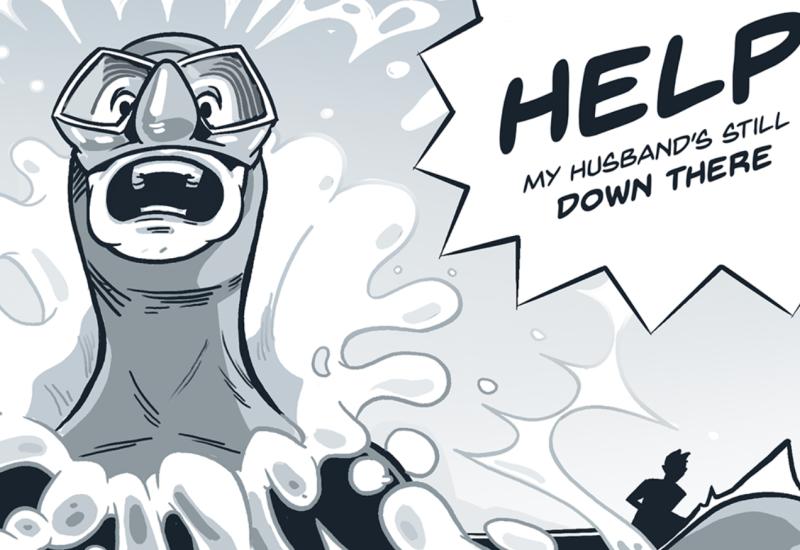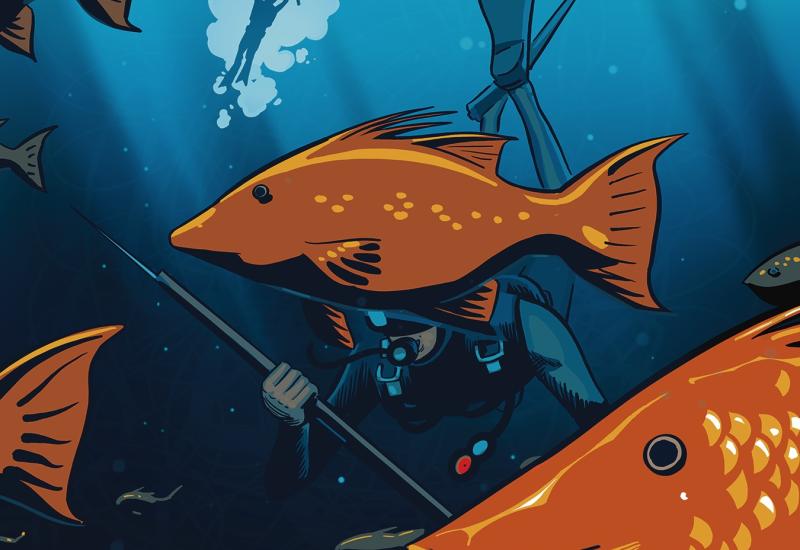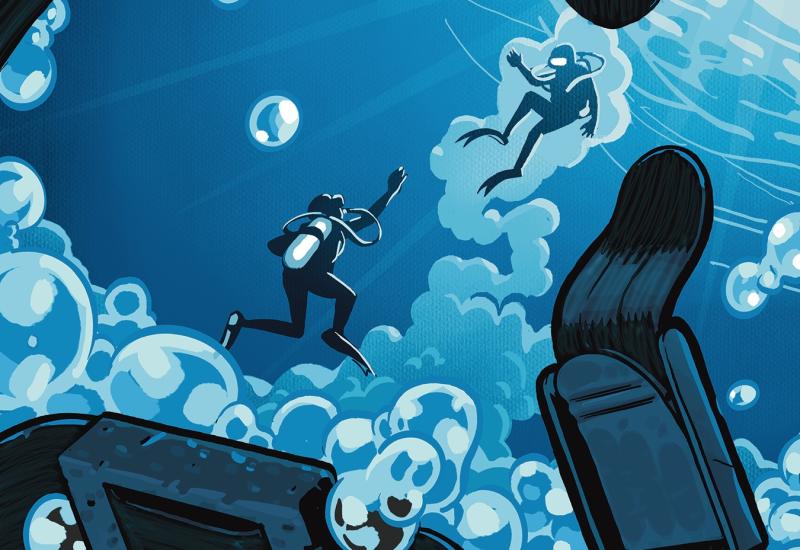Lessons for Life: Diver Panics After Seeing Shark

Nothing to Fear but Fear Itself
Shark sighting causes diver to forget training.
Miko Maciaszek

Wendy loved diving. She loved the sights and the lack of noise. She loved the feeling of the warm water and weightlessness. The only thing she didn’t love was sharks. Misrepresentations of sharks in the media caused her to think that they were nothing more than mindless killing machines. So far, Wendy hadn’t had to face her fear underwater, but then she saw something move on the other side of the reef. Something big.
The Diver
Wendy was in her mid-40s and generally healthy. She had a couple of minor issues with her lower back, but nothing that would keep her from diving.
She had been diving for only a few years, but Wendy enjoyed the social and health benefits of the sport. Her one concern was seeing a shark. She couldn’t pinpoint exactly why she was afraid of them, but the fear was there, never far from her mind.
The Dive
The air was warm and mild, just like the water. Wendy and her buddy, Robert, were making a boat dive in the Caribbean about 40 feet below the surface. Wendy was entranced by the scene: The bright sun dappled the water, giving a kaleidoscopic effect. She had been underwater about 20 minutes, veering away from the boat only to explore nearby reefs and swim-throughs. Swimming slowly through a crack between two coral formations, Wendy caught something out of the corner of her eye that made her stop dead. She wasn’t sure what it was — all she saw was the tail. Wendy’s heart began beating faster and her breathing quickened, but she was more curious than alarmed. She decided to investigate, glancing behind her to make sure Robert was in sight before slowly moving forward.
The Accident
When Wendy didn’t see anything, she began to relax. It must have been her imagination, she thought. And then a 6-foot Caribbean reef shark appeared from between the coral heads. It slowly passed by Wendy a few feet below and 20 feet to her right.
The shark didn’t react at all, but that didn’t matter to Wendy. Her heart rate and breathing immediately escalated. She couldn’t catch her breath, and she was suddenly consumed with fear, convinced the shark was circling around behind her. She twisted in the water to find Robert, but he was snapping photos of the shark as it swam by. “What’s wrong with him?” she thought frantically. “Doesn’t he know we’re in danger?” She started spinning in circles trying to see the shark, but her jerky motions and rapid breathing made things worse. In seconds, the only thing Wendy could think of was getting as far away from the shark as possible. She bolted for the surface.
When Wendy appeared 30 feet from the boat, the crew knew she was in trouble. She was failing her arms and her mask was off. The divemaster signaled to her, asking if she was OK. When she didn’t respond, he grabbed a life ring and dived in to get to her. Wendy wouldn’t follow any commands as he approached, and was only semiconscious when he reached her. Just before she slipped back underwater, the divemaster inflated her BC while dropping her weight belt to make her positively buoyant. He quickly towed Wendy back to the boat and initiated emergency procedures. She was put on high-flow oxygen immediately and was evacuated to a hyperbaric chamber. With time, she was able to make a full recovery.
Analysis
According to the Florida Museum of Natural History, there were 218 shark attacks on divers worldwide between 1820 and 2012. Of those attacks, only 19 percent were fatal. In general, sharks are opportunistic predators, feeding on sick or injured fish in the water, so a big, noisy diver is not on the typical shark’s menu. The real problem in this situation was Wendy’s response to the shark. She let her irrational fear get the best of her, and blocked out her training. She panicked and bolted for the surface instead of calmly and safely making her way back to the boat with her buddy.
Wendy allowed herself to be consumed by fear, failing to exhale on ascent and become positively buoyant at the surface. Her rapid ascent without exhalation caused the air in her lungs to expand, and that expanding air caused an air embolism. The gas bubble tore a hole in her lung tissue and entered her arterial blood supply, then moved to her brain, causing the rapid onset of strokelike symptoms and a loss of consciousness. Her injury was serious; Wendy was lucky to make a full recovery.
Lessons for Life
1. Ascend slowly and never hold your breath. This is the emergency those diving axioms are intended to avoid. Failure to follow them can lead to serious injury or death.
2. Stop, think, breathe, and then act. When you are put into a stressful situation, take a moment to think about the best action before reacting on impulse.
3. Learn about sharks. Sharks are wild predators and should never be taken lightly, but most pose little to no threat to divers. Instead of being feared, these beautiful animals should be respected.
More Lessons for Life:
A Not-So-Smart Night Dive | Fail to Plan, Plan to Fail | Disobedience Spells Disaster
Scuba Diving readers know Eric Douglas as the author of "Lessons for Life," but he's also an adventure writer whose latest novel, Heart of the Maya, has just been released, the fifth in Douglas' Mike Scott dive adventure series. Get a taste of the action with "Sharks on Land," an exclusive Mike Scott short story wherein the protagonist breaks up an illegal shark-finning group in the Bahamas, written just for Scuba Diving's readers.

Miko MaciaszekNothing to Fear but Fear Itself
Shark sighting causes diver to forget training.
Wendy loved diving. She loved the sights and the lack of noise. She loved the feeling of the warm water and weightlessness. The only thing she didn’t love was sharks. Misrepresentations of sharks in the media caused her to think that they were nothing more than mindless killing machines. So far, Wendy hadn’t had to face her fear underwater, but then she saw something move on the other side of the reef. Something big.
The Diver
Wendy was in her mid-40s and generally healthy. She had a couple of minor issues with her lower back, but nothing that would keep her from diving.
She had been diving for only a few years, but Wendy enjoyed the social and health benefits of the sport. Her one concern was seeing a shark. She couldn’t pinpoint exactly why she was afraid of them, but the fear was there, never far from her mind.
The Dive
The air was warm and mild, just like the water. Wendy and her buddy, Robert, were making a boat dive in the Caribbean about 40 feet below the surface. Wendy was entranced by the scene: The bright sun dappled the water, giving a kaleidoscopic effect. She had been underwater about 20 minutes, veering away from the boat only to explore nearby reefs and swim-throughs. Swimming slowly through a crack between two coral formations, Wendy caught something out of the corner of her eye that made her stop dead. She wasn’t sure what it was — all she saw was the tail. Wendy’s heart began beating faster and her breathing quickened, but she was more curious than alarmed. She decided to investigate, glancing behind her to make sure Robert was in sight before slowly moving forward.
The Accident
When Wendy didn’t see anything, she began to relax. It must have been her imagination, she thought. And then a 6-foot Caribbean reef shark appeared from between the coral heads. It slowly passed by Wendy a few feet below and 20 feet to her right.
The shark didn’t react at all, but that didn’t matter to Wendy. Her heart rate and breathing immediately escalated. She couldn’t catch her breath, and she was suddenly consumed with fear, convinced the shark was circling around behind her. She twisted in the water to find Robert, but he was snapping photos of the shark as it swam by. “What’s wrong with him?” she thought frantically. “Doesn’t he know we’re in danger?” She started spinning in circles trying to see the shark, but her jerky motions and rapid breathing made things worse. In seconds, the only thing Wendy could think of was getting as far away from the shark as possible. She bolted for the surface.
When Wendy appeared 30 feet from the boat, the crew knew she was in trouble. She was failing her arms and her mask was off. The divemaster signaled to her, asking if she was OK. When she didn’t respond, he grabbed a life ring and dived in to get to her. Wendy wouldn’t follow any commands as he approached, and was only semiconscious when he reached her. Just before she slipped back underwater, the divemaster inflated her BC while dropping her weight belt to make her positively buoyant. He quickly towed Wendy back to the boat and initiated emergency procedures. She was put on high-flow oxygen immediately and was evacuated to a hyperbaric chamber. With time, she was able to make a full recovery.
Analysis
According to the Florida Museum of Natural History, there were 218 shark attacks on divers worldwide between 1820 and 2012. Of those attacks, only 19 percent were fatal. In general, sharks are opportunistic predators, feeding on sick or injured fish in the water, so a big, noisy diver is not on the typical shark’s menu. The real problem in this situation was Wendy’s response to the shark. She let her irrational fear get the best of her, and blocked out her training. She panicked and bolted for the surface instead of calmly and safely making her way back to the boat with her buddy.
Wendy allowed herself to be consumed by fear, failing to exhale on ascent and become positively buoyant at the surface. Her rapid ascent without exhalation caused the air in her lungs to expand, and that expanding air caused an air embolism. The gas bubble tore a hole in her lung tissue and entered her arterial blood supply, then moved to her brain, causing the rapid onset of strokelike symptoms and a loss of consciousness. Her injury was serious; Wendy was lucky to make a full recovery.
Lessons for Life
1. Ascend slowly and never hold your breath. This is the emergency those diving axioms are intended to avoid. Failure to follow them can lead to serious injury or death.
2. Stop, think, breathe, and then act. When you are put into a stressful situation, take a moment to think about the best action before reacting on impulse.
3. Learn about sharks. Sharks are wild predators and should never be taken lightly, but most pose little to no threat to divers. Instead of being feared, these beautiful animals should be respected.
More Lessons for Life:
A Not-So-Smart Night Dive | Fail to Plan, Plan to Fail | Disobedience Spells Disaster
Scuba Diving readers know Eric Douglas as the author of "Lessons for Life," but he's also an adventure writer whose latest novel, Heart of the Maya, has just been released, the fifth in Douglas' Mike Scott dive adventure series. Get a taste of the action with "Sharks on Land," an exclusive Mike Scott short story wherein the protagonist breaks up an illegal shark-finning group in the Bahamas, written just for Scuba Diving's readers.










